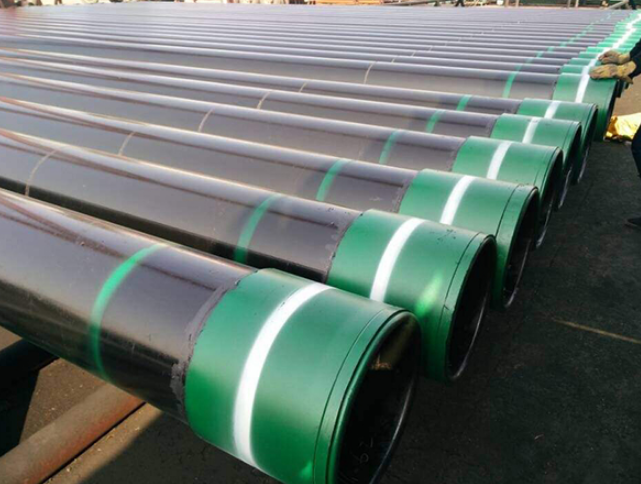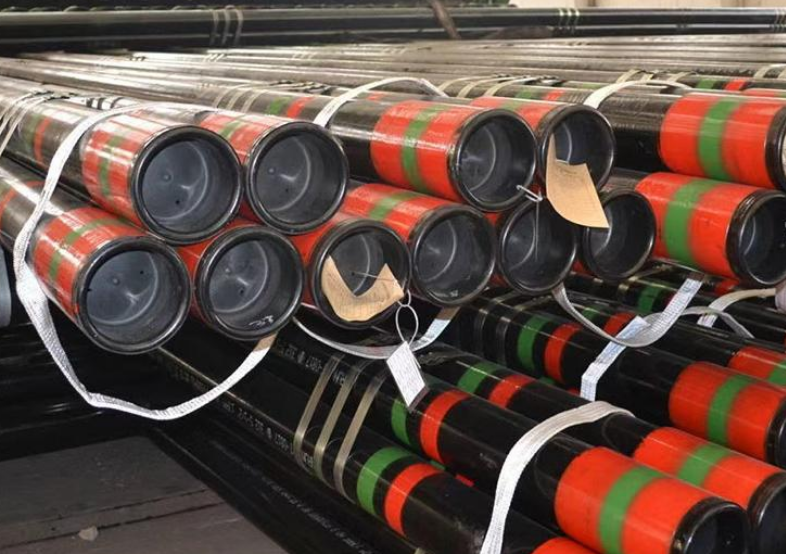
Anti-corrosion Technology of Steel Casing Pipe
There are two main anti-corrosion methods commonly used for petroleum steel casing pipe: coating anti-corrosion and electrical protection.
1. Coating anti-corrosion
Applying paint evenly and densely on the surface of rust-removed metal pipes to isolate them from various corrosive media is one of the most basic methods of pipeline anti-corrosion. Since the 1970s, the laying of pipelines in harsh environments such as polar regions and oceans, as well as the heating and transportation of oil products that increase the temperature of pipelines, have put forward more requirements for coating performance. Therefore, pipeline anti-corrosion coatings are increasingly using composite materials or composite structures.

Things to note when coating and anti-corrosion pipelines:
a. When coating the anti-corrosion layer of steel casing, attention must be paid to environmental factors such as temperature and humidity at the coating site, which directly affect the coating effect. When the steel casing is coated with anti-corrosion coating indoors, the temperature should be controlled at 20-25 degrees Celsius. The relative humidity varies according to the material of the casing, generally around 65%.
b. During outdoor construction, there should be no wind, sand, or drizzle. The temperature should not be lower than 5 degrees Celsius, and the relative humidity should not be greater than 85%. The drying and curing temperatures of the various anti-corrosion coatings used on steel casing vary widely. Generally, epoxy resin coatings cure very slowly below 10 degrees Celsius and are not suitable for winter construction.
Pipe coating material types and usage conditions:
1) Inner wall anti-corrosion coating: a thin film coated on the inner wall of the pipe in order to prevent corrosion inside the pipe, reduce friction resistance, and increase output. Commonly used coatings include amine-cured epoxy resin and polyamide epoxy resin, with a coating thickness of 0.038 to 0.2 mm. In order to ensure that the coating is firmly bonded to the pipe wall, the inner wall of the pipe must be surface treated. Since the 1970s, there has been a tendency to use the same material for the inner and outer wall coatings of pipes, so that the coating of the inner and outer walls of the pipe can be carried out at the same time.
2) Anti-corrosion and thermal insulation coating: In order to reduce the heat dissipation of the pipeline to the soil on medium- and small-diameter thermal pipelines transporting crude oil or fuel oil, a composite layer of insulation and anti-corrosion is added to the outside of the pipeline. The commonly used insulation material is rigid polyurethane foam, with a suitable temperature of -185~95℃. This material has a soft texture. In order to increase its strength, a high-density polyethylene layer is applied outside the insulation layer to form a composite material structure to prevent groundwater from penetrating into the insulation layer.
2. Electrical protection
Electrical protection refers to a method of changing the electrode potential of metal relative to the surrounding medium to protect the metal from corrosion. The electrical protection of long-distance pipelines only refers to cathodic protection and electrical corrosion prevention methods.
① Cathode protection
A method of preventing metal corrosion by polarizing the protected metal into a cathode. This method has been used for ship anti-corrosion for more than 150 years; it was first used in pipelines in 1928. It applied the principle that the cathode in a metal corrosion battery is not corroded but the anode is corroded to metal anti-corrosion technology. Using external current to force all cathodic polarization of the protected metal surface in the electrolyte, corrosion will not occur. There are two indicators to determine whether a pipeline has achieved cathodic protection. One is the minimum protective potential, which is the potential when the metal is cathodicly polarized in the electrolyte and the corrosion process stops; its value is related to environmental and other factors, and the commonly used value is -850 millivolts (relative to the copper-copper sulfate reference electrode Measurement, the same below). The second is the maximum protection potential, which is the highest potential value that the protected metal surface is allowed to reach. When the cathodic polarization is too strong, hydrogen gas will precipitate between the pipe surface and the coating, causing cathodic peeling of the coating. Therefore, the potential of the confluence point must be controlled within the allowable range to prevent the coating from being damaged. This value is related to the properties of the coating, generally between -1.20 and -2.0 volts. There are two ways to achieve cathodic protection of underground pipelines: the impressed current method and the sacrificial anode method.
a. Impressed current method
The impressed current method uses a DC power supply, with the negative electrode connected to the protected pipeline and the positive electrode connected to the anode ground bed. After the circuit is connected, the pipe is cathodically polarized. When the potential of the pipeline to ground reaches the minimum protection potential, complete cathodic protection is obtained. The wiring is shown in Figure 3. Commonly used DC power supplies can be used, especially rectifiers. DC output is generally below 60 volts and 30 amps. New DC power supplies include thermoelectric generators, solar cells, etc., which are mostly used in areas lacking power. The anode ground bed is a conductor that is connected to the positive pole of the DC power supply and forms good electrical contact with the earth, or is called an anode grounding device. Commonly used materials include carbon steel, high silicon ferro, graphite, magnetic iron oxide, etc. The anode ground bed is set in a place where the soil resistivity is low, the protective current is easy to distribute, and does not interfere with adjacent underground structures. The anode corresponds to the buried position of the pipeline, and there are two types: shallow buried long-distance anode and deep anode. In order to measure cathodic protection parameters and identify the cathodic protection effect of pipelines, detection points and inspection sheets need to be set along the pipeline. The supporting detection instruments include high resistance voltmeter, ammeter, copper sulfate electrode, etc.Since the 1970s, cathodic protection parameter telemetry systems combined with pipeline aerial inspections have been used, equipped with electronic computers to process the measured data. The protection distance of a single station of impressed current cathodic protection can generally reach tens of kilometers, and this method is often used for cathodic protection of long-distance pipelines.
b. Sacrificial anode method
The sacrificial anode method uses a metal with a more negative potential than the protected metal electrode to connect to the protected metal, and the two form a primary battery in the electrolyte. Metals with a relatively negative potential (such as magnesium, zinc, aluminum and their alloys) become anodes and are gradually lost in the process of outputting current. The protected pipeline metal becomes a cathode to avoid corrosion, so metals with a relatively negative potential are called sacrifices. anode. Underground pipelines are protected by sacrificial anodes. The determining factors are the current generated by the anodes, the number of anodes and the length of protection. After the anode type is determined, the factors that affect the above parameters are the anode grounding resistance and the leakage resistance between the anode protection pipe section. The former depends on the soil resistivity, and the latter depends on the pipe coating resistance and the construction quality of the coating. The service life of the sacrificial anode is related to its weight and can be used for several years to decades depending on the needs. Sacrificial anodes have the advantages of low investment, simple management, no need for external power supply, and good effect in preventing interference and corrosion, so they are widely used in the anti-corrosion of underground metal pipelines.

② Electric corrosion prevention method
The first is to take measures on facilities related to stray current sources to reduce leakage current to a minimum; the second is to try to avoid stray current areas when laying pipelines, or to improve the quality of the insulation and anti-corrosion layers of the disturbed pipe sections, using shielding, Install insulating flanges and other measures; the third is to provide drainage protection for interference pipelines, that is, to discharge stray current from the interfered pipeline back to the power grid that generates leakage current, so as to eliminate the corrosion of pipelines by stray current. According to the application scope and different performance of the drainage equipment, it can be divided into three types: direct drainage, polar drainage and forced drainage. Many countries have formulated technical regulations for the protection of AC interference voltage, mainly using two methods: safety distance and pipeline leakage to protect pipelines from damage.
Anti-corrosion countermeasures for oil steel casing pipe in actual project applications:
2. For water injection wells that have been newly put into production, use annular protection fluid mainly for sterilization, and form a system to add it regularly;
3. In view of the acceleration effect of mechanical scratches on the corrosion of oil casing, it is recommended to add a rubber ring to the coupling of the oil pipe or a centralizer to the severe deviation of the well to prevent the oil pipe from scratching the casing and during the water injection process. One side contacts the casing;
4. In view of the severe bacterial corrosion under the scale and the slow growth and killing of SRB at high temperatures, high-temperature water or water vapor of 100 degrees Celsius can be regularly injected into the annulus to kill the SRB under the scale;
5. Before the corrosion in the water injection well casing is effectively controlled, it is not recommended to promote the use of cathodic protection and coated casing.
Go here to learn more about " Oil Country Tubular Goods (OCTG)"


